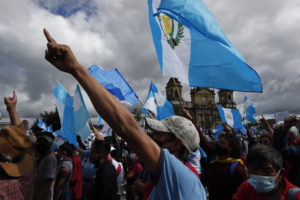THE NORTHERN TRIANGLE IN DATA
The Central America Monitor presents robust quantitative data primarily obtained through official information requests in several key areas. These data assess advances, setbacks, or stalling on specific human rights and rule of law issues from 2014 to 2021. Below, start by viewing the data regionally or clicking on a country. Then, select a section. Under each section, select a specific indicator to explore the corresponding data points. You may also download the raw data or share the graphics.
- GENERAL INFORMATION
- PUBLIC OFFICIALS IN SECURITY AND JUSTICE SECTORS
- VIOLENCE
- BUDGET ALLOCATIONS
- THE JUSTICE SYSTEM
- PUBLIC PERCEPTION AND FAVORABILITY
Honduras, Guatemala and El Salvador have high levels of inequality and poverty. In this section, we display the socioeconomic situation in each country and the region as background for all subsequent sections. We aim to provide broad centralized and reliable data that can serve as a starting point for further investigation. As such, we decided to include disaggregated data only when immediately relevant to the sections we monitor.
!function(){“use strict”;window.addEventListener(“message”,(function(e){if(void 0!==e.data[“datawrapper-height”]){var t=document.querySelectorAll(“iframe”);for(var a in e.data[“datawrapper-height”])for(var r=0;r<t.length;r++){if(t[r].contentWindow===e.source)t[r].style.height=e.data["datawrapper-height"][a]+"px"}}}))}();
Note: In Guatemala, the data shown are derived from estimated population statistics published by the Guatemalan government. They were last updated in 2019; consequently the data here differ from the data published in the Central America Monitor’s baseline reports.
Sources: National Institute of Statistics of Honduras; National Institute of Statistics of Guatemala; data for El Salvador rely on several sources: General Directorate of Statistics and Censuses; United Nations Population Fund; Latin American and Caribbean Demographic Centre, Publication Division of ECLAC.
!function(){“use strict”;window.addEventListener(“message”,(function(a){if(void 0!==a.data[“datawrapper-height”])for(var e in a.data[“datawrapper-height”]){var t=document.getElementById(“datawrapper-chart-“+e)||document.querySelector(“iframe[src*='”+e+”‘]”);t&&(t.style.height=a.data[“datawrapper-height”][e]+”px”)}}))}();
Sources: National Institute of Statistics of Honduras; National Institute of Statistics of Guatemala; data for El Salvador rely on several sources: General Directorate of Statistics and Censuses; United Nations Population Fund; Latin American and Caribbean Demographic Centre, Publication Division of ECLAC.
!function(){“use strict”;window.addEventListener(“message”,(function(e){if(void 0!==e.data[“datawrapper-height”]){var t=document.querySelectorAll(“iframe”);for(var a in e.data[“datawrapper-height”])for(var r=0;r<t.length;r++){if(t[r].contentWindow===e.source)t[r].style.height=e.data["datawrapper-height"][a]+"px"}}}))}();
Notes: None of the three governments update their population projections annually by race or ethnicity. Consequently, the figures shown in a given year derive from the last census that took place: 2013 in Honduras; 2007 in El Salvador; and 2002 and 2018 in Guatemala. According to the groups denominated in the Guatemalan censuses, figures for this country include Mayan, Xinca, and Garífuna people.
Sources: 2013 population census of Honduras; 2007 population and housing census of El Salvador; 2002 and 2018 population censuses of Guatemala.
!function(){“use strict”;window.addEventListener(“message”,(function(e){if(void 0!==e.data[“datawrapper-height”]){var t=document.querySelectorAll(“iframe”);for(var a in e.data[“datawrapper-height”])for(var r=0;r<t.length;r++){if(t[r].contentWindow===e.source)t[r].style.height=e.data["datawrapper-height"][a]+"px"}}}))}();
Notes: None of the three governments update their population projections annually by race or ethnicity. Consequently, the figures shown in a given year derive from the last census that took place: 2013 in Honduras and 2018 in Guatemala. El Salvador’s 2007 census and Guatemala’s 2002 censuses did not include denominations for afro-descendants.
Sources: 2013 population census of Honduras; 2007 population and housing census of El Salvador; 2002 and 2018 population censuses of Guatemala.
!function(){“use strict”;window.addEventListener(“message”,(function(e){if(void 0!==e.data[“datawrapper-height”]){var t=document.querySelectorAll(“iframe”);for(var a in e.data[“datawrapper-height”])for(var r=0;r<t.length;r++){if(t[r].contentWindow===e.source)t[r].style.height=e.data["datawrapper-height"][a]+"px"}}}))}();
Sources: National Institute of Statistics of Honduras; General Directorate of Statistics and Censuses of El Salvador; World Bank.
!function(){“use strict”;window.addEventListener(“message”,(function(e){if(void 0!==e.data[“datawrapper-height”]){var t=document.querySelectorAll(“iframe”);for(var a in e.data[“datawrapper-height”])for(var r=0;r<t.length;r++){if(t[r].contentWindow===e.source)t[r].style.height=e.data["datawrapper-height"][a]+"px"}}}))}();
Sources: National Institute of Statistics of Honduras; General Directorate of Statistics and Censuses of El Salvador; World Bank.
!function(){“use strict”;window.addEventListener(“message”,(function(e){if(void 0!==e.data[“datawrapper-height”]){var t=document.querySelectorAll(“iframe”);for(var a in e.data[“datawrapper-height”])for(var r=0;r<t.length;r++){if(t[r].contentWindow===e.source)t[r].style.height=e.data["datawrapper-height"][a]+"px"}}}))}();
Note: Figures shown were taken from the World Bank, which included the following note: “GDP at purchaser’s prices is the sum of gross value added by all resident producers in the economy plus any product taxes and minus any subsidies not included in the value of the products. It is calculated without making deductions for depreciation of fabricated assets or for depletion and degradation of natural resources. Data are in current U.S. dollars. Dollar figures for GDP are converted from domestic currencies using single year official exchange rates. For a few countries where the official exchange rate does not reflect the rate effectively applied to actual foreign exchange transactions, an alternative conversion factor is used.”
Source: World Bank (accessed June 2021).
!function(){“use strict”;window.addEventListener(“message”,(function(a){if(void 0!==a.data[“datawrapper-height”])for(var e in a.data[“datawrapper-height”]){var t=document.getElementById(“datawrapper-chart-“+e)||document.querySelector(“iframe[src*='”+e+”‘]”);t&&(t.style.height=a.data[“datawrapper-height”][e]+”px”)}}))}();
Note: All amounts have been converted to United States Dollars using exchange rates of 24.6 Honduran Lempiras and 7.7 Guatemalan Quetzales. In Honduras, the rates were calculated using the average minimum salary assuming a standard work day of eight hours. In El Salvador, the rates were calculated using the average minimum salary that the government established for different sectors: commerce and services; maquila and textiles; industry; crop collection; seasonal agriculture; and agricultural and livestock farming.
Sources: Ministry of Labor and Social Security and Central Bank of Honduras; Ministry of Labor and Social Welfare of El Salvador; Ministry of Labor and Social Welfare and Bank of Guatemala.
!function(){“use strict”;window.addEventListener(“message”,(function(e){if(void 0!==e.data[“datawrapper-height”]){var t=document.querySelectorAll(“iframe”);for(var a in e.data[“datawrapper-height”])for(var r=0;r<t.length;r++){if(t[r].contentWindow===e.source)t[r].style.height=e.data["datawrapper-height"][a]+"px"}}}))}();
Notes: All amounts have been converted to United States Dollars using exchange rates of 24.6 Honduran Lempiras and 7.7 Guatemalan Quetzales. The figures shown were calculated to represent per capita costs of basic provisions, known as the “basic basket of goods” (canasta básica). In El Salvador, the figures represent the average cost of basic food provisions for rural and urban areas. In Guatemala, the figures represent the average rates of “basic vital goods” (canasta básica vital) and “basic expanded goods” (canasta básica ampliada) from January 2014 through September 2017, and the new “basic expanded goods” rate as of October 2017.
Sources: National Autonomous University of Honduras; General Directorate of Statistics and Censuses of El Salvador; National Statistics Institute of Guatemala.
!function(){“use strict”;window.addEventListener(“message”,(function(e){if(void 0!==e.data[“datawrapper-height”]){var t=document.querySelectorAll(“iframe”);for(var a in e.data[“datawrapper-height”])for(var r=0;r<t.length;r++){if(t[r].contentWindow===e.source)t[r].style.height=e.data["datawrapper-height"][a]+"px"}}}))}();
Sources: National Statistics Institute of Honduras; General Directorate of Statistics and Censuses of El Salvador; National Statistics Institute of Guatemala.
!function(){“use strict”;window.addEventListener(“message”,(function(e){if(void 0!==e.data[“datawrapper-height”]){var t=document.querySelectorAll(“iframe”);for(var a in e.data[“datawrapper-height”])for(var r=0;r<t.length;r++){if(t[r].contentWindow===e.source)t[r].style.height=e.data["datawrapper-height"][a]+"px"}}}))}();
Note: The poverty rate in Guatemala derives from the 2014 census. There are no available updated figures after this year, so we have listed the same rate for ensuing years.
Sources: National Statistics Institute of Honduras; General Directorate of Statistics and Censuses of El Salvador; National Statistics Institute of Guatemala.
!function(){“use strict”;window.addEventListener(“message”,(function(e){if(void 0!==e.data[“datawrapper-height”]){var t=document.querySelectorAll(“iframe”);for(var a in e.data[“datawrapper-height”])for(var r=0;r<t.length;r++)t[r].contentWindow===e.source&&(t[r].style.height=e.data["datawrapper-height"][a]+"px")}}))}();
Notes: The literacy rate refers to the percentage of people who can read and write, and includes: those older than 15 in Honduras; those older than 10 years in El Salvador; those older than 14 years in Guatemala.
Sources: National Statistics Institute of Honduras; General Directorate of Statistics and Censuses of El Salvador; National Statistics Institute of Guatemala; World Bank.
!function(){“use strict”;window.addEventListener(“message”,(function(a){if(void 0!==a.data[“datawrapper-height”])for(var e in a.data[“datawrapper-height”]){var t=document.getElementById(“datawrapper-chart-“+e)||document.querySelector(“iframe[src*='”+e+”‘]”);t&&(t.style.height=a.data[“datawrapper-height”][e]+”px”)}}))}();
Sources: National Statistics Institute of Honduras; General Directorate of Statistics and Censuses of El Salvador; World Bank.
A look at the institutional capacity of justice, security, and defense institutions in El Salvador, Guatemala, and Honduras, focusing on geographical access and allocation of human resources, the number of public officials per 100,000 inhabitants, and the proportion of female personnel among key positions.
!function(){“use strict”;window.addEventListener(“message”,(function(e){if(void 0!==e.data[“datawrapper-height”]){var t=document.querySelectorAll(“iframe”);for(var a in e.data[“datawrapper-height”])for(var r=0;r<t.length;r++){if(t[r].contentWindow===e.source)t[r].style.height=e.data["datawrapper-height"][a]+"px"}}}))}();
Note: In Honduras, the figures show the total number of judges and magistrates, as the Judiciary does not store information by year on the number of judges with criminal jurisdiction.
Sources: Judiciary and National Institute of Statistics of Honduras; Judiciary and General Directorate of Statistics and the Census of El Salvador; Judiciary and National Institute of Statistics of Guatemala.
!function(){“use strict”;window.addEventListener(“message”,(function(e){if(void 0!==e.data[“datawrapper-height”]){var t=document.querySelectorAll(“iframe”);for(var a in e.data[“datawrapper-height”])for(var r=0;r<t.length;r++){if(t[r].contentWindow===e.source)t[r].style.height=e.data["datawrapper-height"][a]+"px"}}}))}();
Note: In Guatemala and Honduras, the figures show the total number of prosecutors, since data was not available on the number of prosecutors in criminal matters.
Sources: Public Prosecutor’s Office and National Institute of Statistics of Honduras; Public Prosecutor’s Office and General Directorate of Statistics and the Census of Guatemala; Public Prosecutor’s Office and National Institute of Statistics of El Salvador.
!function(){“use strict”;window.addEventListener(“message”,(function(e){if(void 0!==e.data[“datawrapper-height”]){var t=document.querySelectorAll(“iframe”);for(var a in e.data[“datawrapper-height”])for(var r=0;r<t.length;r++){if(t[r].contentWindow===e.source)t[r].style.height=e.data["datawrapper-height"][a]+"px"}}}))}();
Sources: Public Prosecutor’s Office and National Institute of Statistics of Honduras; Institute of Forensic Medicine and General Directorate of Statistics and the Census of El Salvador; National Institute of Forensic Science and National Institute of Statistics of Guatemala.
!function(){“use strict”;window.addEventListener(“message”,(function(e){if(void 0!==e.data[“datawrapper-height”]){var t=document.querySelectorAll(“iframe”);for(var a in e.data[“datawrapper-height”])for(var r=0;r<t.length;r++){if(t[r].contentWindow===e.source)t[r].style.height=e.data["datawrapper-height"][a]+"px"}}}))}();
Sources: Judiciary and National Institute of Statistics of Honduras; Public Defender’s Office of the Republic and General Directorate of Statistics and the Census of El Salvador; Institute of Criminal Public Defense and National Institute of Statistics of Guatemala.
!function(){“use strict”;window.addEventListener(“message”,(function(e){if(void 0!==e.data[“datawrapper-height”]){var t=document.querySelectorAll(“iframe”);for(var a in e.data[“datawrapper-height”])for(var r=0;r<t.length;r++){if(t[r].contentWindow===e.source)t[r].style.height=e.data["datawrapper-height"][a]+"px"}}}))}();
Sources: National Police of Honduras, Special Commission to Purge and Transform the Honduran National Police, and National Institute of Statistics of Honduras; National Civilian Police and General Directorate of Statistics and the Census of El Salvador; National Civilian Police and National Institute of Statistics of Guatemala.
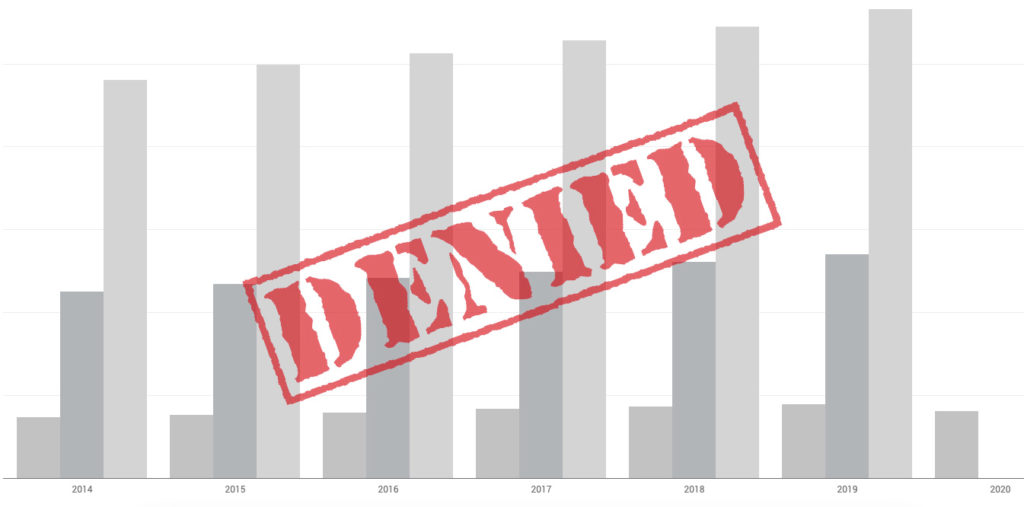
Note: The ministries of defense of all three countries denied our requests for information regarding the number of military personnel.
Sources: Ministry of Defense of Honduras; Ministry of Defense of El Salvador; Ministry of Defense of Guatemala.
!function(){“use strict”;window.addEventListener(“message”,(function(e){if(void 0!==e.data[“datawrapper-height”]){var t=document.querySelectorAll(“iframe”);for(var a in e.data[“datawrapper-height”])for(var r=0;r<t.length;r++)t[r].contentWindow===e.source&&(t[r].style.height=e.data["datawrapper-height"][a]+"px")}}))}();
Note: In Guatemala and Honduras, the figures show the total number of prosecutors, since data was not available on the number of prosecutors in criminal matters.
Sources: Public Prosecutor’s Office and National Institute of Statistics of Honduras; Public Prosecutor’s Office and General Directorate of Statistics and the Census of El Salvador; Public Prosecutor’s Office and National Institute of Statistics of Guatemala.
!function(){“use strict”;window.addEventListener(“message”,(function(e){if(void 0!==e.data[“datawrapper-height”]){var t=document.querySelectorAll(“iframe”);for(var a in e.data[“datawrapper-height”])for(var r=0;r<t.length;r++){if(t[r].contentWindow===e.source)t[r].style.height=e.data["datawrapper-height"][a]+"px"}}}))}();
Note: In Honduras, the figures show the total number of judges and magistrates, as the Judiciary does not store information by year on the number of judges with criminal jurisdiction.
Sources: Judiciary and National Institute of Statistics of Honduras; Judiciary and General Directorate of Statistics and the Census of El Salvador; Judiciary and National Institute of Statistics of Guatemala.
!function(){“use strict”;window.addEventListener(“message”,(function(e){if(void 0!==e.data[“datawrapper-height”]){var t=document.querySelectorAll(“iframe”);for(var a in e.data[“datawrapper-height”])for(var r=0;r<t.length;r++){if(t[r].contentWindow===e.source)t[r].style.height=e.data["datawrapper-height"][a]+"px"}}}))}();
Sources: Public Prosecutor’s Office and National Institute of Statistics of Honduras; Institute of Forensic Medicine of El Salvador; National Institute of Forensic Science and National Institute of Statistics of Guatemala.
!function(){“use strict”;window.addEventListener(“message”,(function(e){if(void 0!==e.data[“datawrapper-height”]){var t=document.querySelectorAll(“iframe”);for(var a in e.data[“datawrapper-height”])for(var r=0;r<t.length;r++){if(t[r].contentWindow===e.source)t[r].style.height=e.data["datawrapper-height"][a]+"px"}}}))}();
Sources: Judiciary and National Institute of Statistics of Honduras; Public Defender’s Office of the Republic and General Directorate of Statistics and the Census of El Salvador; Institute of Criminal Public Defense and National Institute of Statistics of Guatemala.
!function(){“use strict”;window.addEventListener(“message”,(function(e){if(void 0!==e.data[“datawrapper-height”]){var t=document.querySelectorAll(“iframe”);for(var a in e.data[“datawrapper-height”])for(var r=0;r<t.length;r++){if(t[r].contentWindow===e.source)t[r].style.height=e.data["datawrapper-height"][a]+"px"}}}))}();
Note: The ministries of defense of Honduras and Guatemala denied our requests for information regarding the number of military personnel, including the number of troops dedicated to internal policing functions.
Sources: Ministry of Defense of Honduras; Ministry of Defense of El Salvador; Ministry of Defense of Guatemala.
!function(){“use strict”;window.addEventListener(“message”,(function(e){if(void 0!==e.data[“datawrapper-height”]){var t=document.querySelectorAll(“iframe”);for(var a in e.data[“datawrapper-height”])for(var r=0;r<t.length;r++){if(t[r].contentWindow===e.source)t[r].style.height=e.data["datawrapper-height"][a]+"px"}}}))}();
Note: In Honduras, the figures show the proportion of women for the total number of judges and magistrates, as the Judiciary does not store information by year on the number of judges with criminal jurisdiction. In El Salvador, it was not possible to obtain data on the number of women in this position.
Sources: Judiciary and National Institute of Statistics of Honduras; Judiciary of El Salvador; Judiciary and National Institute of Statistics of Guatemala.
!function(){“use strict”;window.addEventListener(“message”,(function(e){if(void 0!==e.data[“datawrapper-height”]){var t=document.querySelectorAll(“iframe”);for(var a in e.data[“datawrapper-height”])for(var r=0;r<t.length;r++){if(t[r].contentWindow===e.source)t[r].style.height=e.data["datawrapper-height"][a]+"px"}}}))}();
Note: In El Salvador, it was not possible to obtain data on the number of women in this position.
Sources: Public Prosecutor’s Office and National Institute of Statistics of Honduras; Institute of Forensic Medicine of El Salvador; National Institute of Forensic Science and National Institute of Statistics of Guatemala.
!function(){“use strict”;window.addEventListener(“message”,(function(e){if(void 0!==e.data[“datawrapper-height”]){var t=document.querySelectorAll(“iframe”);for(var a in e.data[“datawrapper-height”])for(var r=0;r<t.length;r++){if(t[r].contentWindow===e.source)t[r].style.height=e.data["datawrapper-height"][a]+"px"}}}))}();
Note: In El Salvador, it was not possible to obtain data on the number of women in this position.
Sources: Judiciary and National Institute of Statistics of Honduras; Public Defender’s Office of the Republic of El Salvador; Institute of Criminal Public Defense and National Institute of Statistics of Guatemala.
!function(){“use strict”;window.addEventListener(“message”,(function(e){if(void 0!==e.data[“datawrapper-height”]){var t=document.querySelectorAll(“iframe”);for(var a in e.data[“datawrapper-height”])for(var r=0;r<t.length;r++){if(t[r].contentWindow===e.source)t[r].style.height=e.data["datawrapper-height"][a]+"px"}}}))}();
Sources: National Police; National Civilian Police of El Salvador; National Civilian Police of Guatemala.

Note: The ministries of defense of all three countries denied our requests for information regarding the number of military personnel, including their breakdown by sex.
Sources: Ministry of Defense of Honduras; Ministry of Defense of El Salvador; Ministry of Defense of Guatemala.
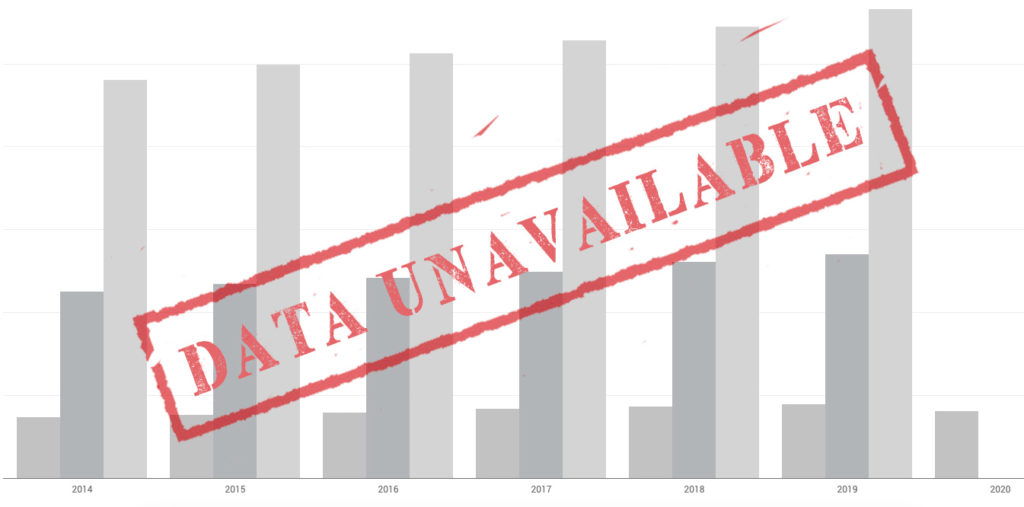
Sources: Public Prosecutor’s Office of Honduras; Public Prosecutor’s Office of El Salvador; Public Prosecutor’s Office of Guatemala.
!function(){“use strict”;window.addEventListener(“message”,(function(e){if(void 0!==e.data[“datawrapper-height”]){var t=document.querySelectorAll(“iframe”);for(var a in e.data[“datawrapper-height”])for(var r=0;r<t.length;r++){if(t[r].contentWindow===e.source)t[r].style.height=e.data["datawrapper-height"][a]+"px"}}}))}();
Note: In Guatemala and Honduras, the figures represent the total number of prosecutors, since data was not available on the number of prosecutors in criminal matters.
Sources: Public Prosecutor’s Office and National Institute of Statistics of Honduras; Public Prosecutor’s Office and General Directorate of Statistics and the Census of El Salvador; Public Prosecutor’s Office and National Institute of Statistics of Guatemala.
!function(){“use strict”;window.addEventListener(“message”,(function(e){if(void 0!==e.data[“datawrapper-height”]){var t=document.querySelectorAll(“iframe”);for(var a in e.data[“datawrapper-height”])for(var r=0;r<t.length;r++){if(t[r].contentWindow===e.source)t[r].style.height=e.data["datawrapper-height"][a]+"px"}}}))}();
Note: In Honduras, the figures represent the total number of judges and magistrates, as the Judiciary does not store information by year on the number of judges with criminal jurisdiction.
Sources: Judiciary and National Institute of Statistics of Honduras; Judiciary and General Directorate of Statistics and the Census of El Salvador; Judiciary and National Institute of Statistics of Guatemala.
!function(){“use strict”;window.addEventListener(“message”,(function(e){if(void 0!==e.data[“datawrapper-height”]){var t=document.querySelectorAll(“iframe”);for(var a in e.data[“datawrapper-height”])for(var r=0;r<t.length;r++){if(t[r].contentWindow===e.source)t[r].style.height=e.data["datawrapper-height"][a]+"px"}}}))}();
Sources: Public Prosecutor’s Office and National Institute of Statistics of Honduras; Institute of Forensic Medicine of El Salvador; National Institute of Forensic Science and National Institute of Statistics of Guatemala.
!function(){“use strict”;window.addEventListener(“message”,(function(e){if(void 0!==e.data[“datawrapper-height”]){var t=document.querySelectorAll(“iframe”);for(var a in e.data[“datawrapper-height”])for(var r=0;r<t.length;r++){if(t[r].contentWindow===e.source)t[r].style.height=e.data["datawrapper-height"][a]+"px"}}}))}();
Sources: Judiciary and National Institute of Statistics of Honduras; Public Defender’s Office of the Republic and General Directorate of Statistics and the Census of El Salvador; Institute of Criminal Public Defense and National Institute of Statistics of Guatemala.
!function(){“use strict”;window.addEventListener(“message”,(function(e){if(void 0!==e.data[“datawrapper-height”]){var t=document.querySelectorAll(“iframe”);for(var a in e.data[“datawrapper-height”])for(var r=0;r<t.length;r++){if(t[r].contentWindow===e.source)t[r].style.height=e.data["datawrapper-height"][a]+"px"}}}))}();
Sources: National Police, Special Commission to Purge and Transform the Honduran National Police, and National Institute of Statistics of Honduras; National Civilian Police and General Directorate of Statistics and the Census of El Salvador; National Civilian Police and National Institute of Statistics of Guatemala.
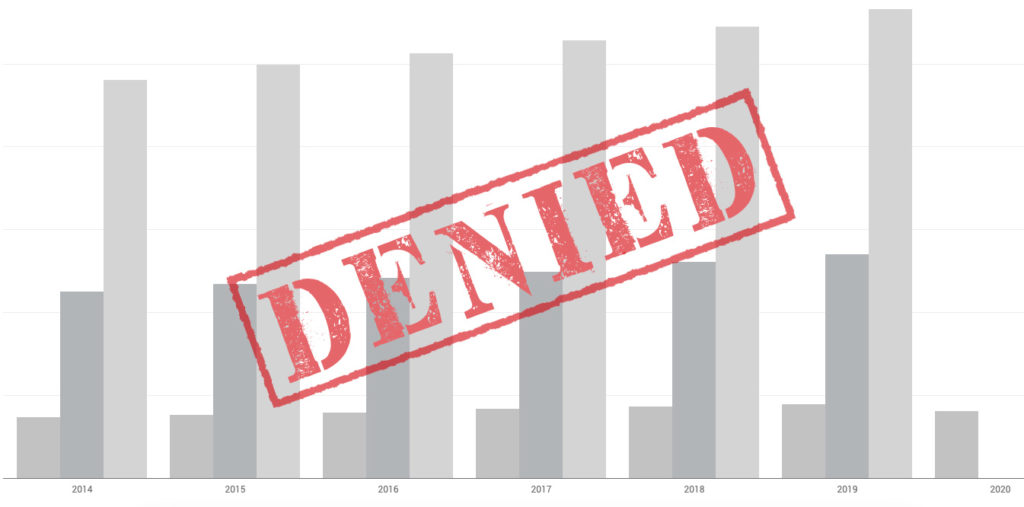
Note: The ministries of defense of all three countries denied our requests for information regarding the number of military personnel.
Sources: Ministry of Defense of Honduras; Ministry of Defense of El Salvador; Ministry of Defense of Guatemala.
Honduras, Guatemala and El Salvador have among the world’s highest homicide rates and high rates of extortion and sexual violence, even though the latter are gravely underreported. We chose these crimes, because while homicide is the serious crime that most affects males, sexual violence is the serious crime that most affects females, and extortion affects broad segments of all sectors of society. We show how few cases actually enter the justice system and end in sentencing, thus creating a cycle of impunity for even the worst crimes.
!function(){“use strict”;window.addEventListener(“message”,(function(e){if(void 0!==e.data[“datawrapper-height”]){var t=document.querySelectorAll(“iframe”);for(var a in e.data[“datawrapper-height”])for(var r=0;r<t.length;r++){if(t[r].contentWindow===e.source)t[r].style.height=e.data["datawrapper-height"][a]+"px"}}}))}();
Note: Each country has a different classification for violent deaths of women, such as femicide and feminicide, as well as overall killings disaggregated by sex. The data shown includes relevant available total data from each country.
Sources: Public Prosecutor’s Office of Honduras; Public Prosecutor’s Office of El Salvador; National Civilian Police and Diálogos of Guatemala.
!function(){“use strict”;window.addEventListener(“message”,(function(e){if(void 0!==e.data[“datawrapper-height”]){var t=document.querySelectorAll(“iframe”);for(var a in e.data[“datawrapper-height”])for(var r=0;r<t.length;r++){if(t[r].contentWindow===e.source)t[r].style.height=e.data["datawrapper-height"][a]+"px"}}}))}();
Note: Each country has a different classification for violent deaths of women, such as femicide and feminicide, as well as overall killings disaggregated by sex. The data shown includes relevant available total data from each country.
Sources: Public Prosecutor’s Office of Honduras; Public Prosecutor’s Office of El Salvador; National Civilian Police and Diálogos of Guatemala.
!function(){“use strict”;window.addEventListener(“message”,(function(e){if(void 0!==e.data[“datawrapper-height”]){var t=document.querySelectorAll(“iframe”);for(var a in e.data[“datawrapper-height”])for(var r=0;r<t.length;r++){if(t[r].contentWindow===e.source)t[r].style.height=e.data["datawrapper-height"][a]+"px"}}}))}();
Sources: Public Prosecutor’s Office of Honduras; Public Prosecutor’s Office of El Salvador; Public Prosecutor’s Office of Guatemala.
!function(){“use strict”;window.addEventListener(“message”,(function(e){if(void 0!==e.data[“datawrapper-height”]){var t=document.querySelectorAll(“iframe”);for(var a in e.data[“datawrapper-height”])for(var r=0;r<t.length;r++){if(t[r].contentWindow===e.source)t[r].style.height=e.data["datawrapper-height"][a]+"px"}}}))}();
Sources: Public Prosecutor’s Office of Honduras; Public Prosecutor’s Office of El Salvador; Public Prosecutor’s Office of Guatemala.
!function(){“use strict”;window.addEventListener(“message”,(function(e){if(void 0!==e.data[“datawrapper-height”]){var t=document.querySelectorAll(“iframe”);for(var a in e.data[“datawrapper-height”])for(var r=0;r<t.length;r++){if(t[r].contentWindow===e.source)t[r].style.height=e.data["datawrapper-height"][a]+"px"}}}))}();
Sources: Unit for the Protection of Human Rights Defenders in Guatemala. In Honduras, data was compiled from a variety of sources: Inter-American Commission on Human Rights; United Nations; National Human Rights Commission of Honduras; ACI-Participa; Center for Human Rights Promotion and Research; Frontline Defenders; National Democratic Institute; National Violence Observatory at the UNAH.
!function(){“use strict”;window.addEventListener(“message”,(function(e){if(void 0!==e.data[“datawrapper-height”]){var t=document.querySelectorAll(“iframe”);for(var a in e.data[“datawrapper-height”])for(var r=0;r<t.length;r++){if(t[r].contentWindow===e.source)t[r].style.height=e.data["datawrapper-height"][a]+"px"}}}))}();
Sources: Public Prosecutor’s Office of Honduras; Public Prosecutor’s Office of El Salvador; Public Prosecutor’s Office of Guatemala.
!function(){“use strict”;window.addEventListener(“message”,(function(e){if(void 0!==e.data[“datawrapper-height”]){var t=document.querySelectorAll(“iframe”);for(var a in e.data[“datawrapper-height”])for(var r=0;r<t.length;r++){if(t[r].contentWindow===e.source)t[r].style.height=e.data["datawrapper-height"][a]+"px"}}}))}();
Sources: Public Prosecutor’s Office of Honduras; Public Prosecutor’s Office of El Salvador; Public Prosecutor’s Office of Guatemala.
!function(){“use strict”;window.addEventListener(“message”,(function(e){if(void 0!==e.data[“datawrapper-height”]){var t=document.querySelectorAll(“iframe”);for(var a in e.data[“datawrapper-height”])for(var r=0;r<t.length;r++){if(t[r].contentWindow===e.source)t[r].style.height=e.data["datawrapper-height"][a]+"px"}}}))}();
Sources: Public Prosecutor’s Office of Honduras; Public Prosecutor’s Office of El Salvador; Public Prosecutor’s Office of Guatemala.
!function(){“use strict”;window.addEventListener(“message”,(function(e){if(void 0!==e.data[“datawrapper-height”]){var t=document.querySelectorAll(“iframe”);for(var a in e.data[“datawrapper-height”])for(var r=0;r<t.length;r++){if(t[r].contentWindow===e.source)t[r].style.height=e.data["datawrapper-height"][a]+"px"}}}))}();
Sources: Public Prosecutor’s Office of Honduras; Public Prosecutor’s Office of El Salvador; Public Prosecutor’s Office of Guatemala.
!function(){“use strict”;window.addEventListener(“message”,(function(a){if(void 0!==a.data[“datawrapper-height”])for(var e in a.data[“datawrapper-height”]){var t=document.getElementById(“datawrapper-chart-“+e)||document.querySelector(“iframe[src*='”+e+”‘]”);t&&(t.style.height=a.data[“datawrapper-height”][e]+”px”)}}))}();
Note: In Guatemala and El Salvador, the figures also include cases of abductions (plagio) and deprivation of liberty (privación de libertad), respectively.
Sources: Public Prosecutor’s Office of Honduras; Public Prosecutor’s Office of El Salvador; Public Prosecutor’s Office of Guatemala.
Comparative data on the allocation of public resources among justice, security, defense, health, and education institutions to show an approximation of governments’ funding priorities over time.
- Education
- Health
- Defense
- National Police
- Forensic Medicine
- Public Defender's Office
- Judiciary
- Public Prosecutor's Office
- Total National Budget
!function(){“use strict”;window.addEventListener(“message”,(function(e){if(void 0!==e.data[“datawrapper-height”]){var t=document.querySelectorAll(“iframe”);for(var a in e.data[“datawrapper-height”])for(var r=0;r<t.length;r++){if(t[r].contentWindow===e.source)t[r].style.height=e.data["datawrapper-height"][a]+"px"}}}))}();
Note: All amounts have been converted to United States Dollars using exchange rates of 24.6 Honduran Lempiras and 7.7 Guatemalan Quetzales.
Sources: Ministry of Finance of Honduras; Ministry of Education, Science and Technology of El Salvador; Ministry of Education of Guatemala.
!function(){“use strict”;window.addEventListener(“message”,(function(e){if(void 0!==e.data[“datawrapper-height”]){var t=document.querySelectorAll(“iframe”);for(var a in e.data[“datawrapper-height”])for(var r=0;r<t.length;r++){if(t[r].contentWindow===e.source)t[r].style.height=e.data["datawrapper-height"][a]+"px"}}}))}();
Note: All amounts have been converted to United States Dollars using exchange rates of 24.6 Honduran Lempiras and 7.7 Guatemalan Quetzales.
Sources: Ministry of Finance of Honduras; Ministry of Health of El Salvador; Ministry of Public Health and Social Assistance of Guatemala.
!function(){“use strict”;window.addEventListener(“message”,(function(e){if(void 0!==e.data[“datawrapper-height”]){var t=document.querySelectorAll(“iframe”);for(var a in e.data[“datawrapper-height”])for(var r=0;r<t.length;r++){if(t[r].contentWindow===e.source)t[r].style.height=e.data["datawrapper-height"][a]+"px"}}}))}();
Note: All amounts have been converted to United States Dollars using exchange rates of 24.6 Honduran Lempiras and 7.7 Guatemalan Quetzales.
Sources: Official Newspaper (La Gaceta) of Honduras; Ministry of Finance of El Salvador; Integrated Accounting System of Guatemala.
!function(){“use strict”;window.addEventListener(“message”,(function(e){if(void 0!==e.data[“datawrapper-height”]){var t=document.querySelectorAll(“iframe”);for(var a in e.data[“datawrapper-height”])for(var r=0;r<t.length;r++){if(t[r].contentWindow===e.source)t[r].style.height=e.data["datawrapper-height"][a]+"px"}}}))}();
Note: All amounts have been converted to United States Dollars using exchange rates of 24.6 Honduran Lempiras and 7.7 Guatemalan Quetzales.
Sources: Association for a More Just Society, Official Newspaper (La Gaceta), and Superior Court of Accounts of Honduras; Ministry of Finance of El Salvador; National Civilian Police of Guatemala.
!function(){“use strict”;window.addEventListener(“message”,(function(e){if(void 0!==e.data[“datawrapper-height”]){var t=document.querySelectorAll(“iframe”);for(var a in e.data[“datawrapper-height”])for(var r=0;r<t.length;r++){if(t[r].contentWindow===e.source)t[r].style.height=e.data["datawrapper-height"][a]+"px"}}}))}();
Note: All amounts have been converted to United States Dollars using exchange rates of 24.6 Honduran Lempiras and 7.7 Guatemalan Quetzales.
Sources: Public Prosecutor’s Office of Honduras; Ministry of Finance of El Salvador; National Institute of Forensic Science of Guatemala.
!function(){“use strict”;window.addEventListener(“message”,(function(e){if(void 0!==e.data[“datawrapper-height”]){var t=document.querySelectorAll(“iframe”);for(var a in e.data[“datawrapper-height”])for(var r=0;r<t.length;r++){if(t[r].contentWindow===e.source)t[r].style.height=e.data["datawrapper-height"][a]+"px"}}}))}();
Note: No data was available on budget allocations for this institution in Honduras. All amounts have been converted to United States Dollars using exchange rate of 7.7 Guatemalan Quetzales.
Sources: Ministry of Finance of El Salvador; Institute of Criminal Public Defense of Guatemala.
!function(){“use strict”;window.addEventListener(“message”,(function(a){if(void 0!==a.data[“datawrapper-height”])for(var e in a.data[“datawrapper-height”]){var t=document.getElementById(“datawrapper-chart-“+e)||document.querySelector(“iframe[src*='”+e+”‘]”);t&&(t.style.height=a.data[“datawrapper-height”][e]+”px”)}}))}();
Note: All amounts have been converted to United States Dollars using exchange rates of 24.6 Honduran Lempiras and 7.7 Guatemalan Quetzales.
Sources: Superior Court of Accounts of Honduras; Ministry of Finance of El Salvador; Judiciary of Guatemala.
!function(){“use strict”;window.addEventListener(“message”,(function(e){if(void 0!==e.data[“datawrapper-height”]){var t=document.querySelectorAll(“iframe”);for(var a in e.data[“datawrapper-height”])for(var r=0;r<t.length;r++){if(t[r].contentWindow===e.source)t[r].style.height=e.data["datawrapper-height"][a]+"px"}}}))}();
Note: All amounts have been converted to United States Dollars using exchange rates of 24.6 Honduran Lempiras and 7.7 Guatemalan Quetzales.
Sources: Superior Court of Accounts of Honduras; Ministry of Finance of El Salvador; Public Prosecutor’s Office of Guatemala.
!function(){“use strict”;window.addEventListener(“message”,(function(e){if(void 0!==e.data[“datawrapper-height”]){var t=document.querySelectorAll(“iframe”);for(var a in e.data[“datawrapper-height”])for(var r=0;r<t.length;r++){if(t[r].contentWindow===e.source)t[r].style.height=e.data["datawrapper-height"][a]+"px"}}}))}();
Note: All amounts have been converted to United States Dollars using exchange rates of 24.6 Honduran Lempiras and 7.7 Guatemalan Quetzales.
Sources: Official Newspaper of Honduras (La Gaceta); Ministry of Finance of El Salvador; Ministry of Public Finances of Guatemala.
The justice system faces numerous challenges in each country. To provide national context to the other sections and a jumping-off point for comparisons with other countries outside the region, we display the global totals of all crimes, budget, staff and particularly relevant personnel for three categories: the prosecution, judiciary and public defense.
!function(){“use strict”;window.addEventListener(“message”,(function(e){if(void 0!==e.data[“datawrapper-height”]){var t=document.querySelectorAll(“iframe”);for(var a in e.data[“datawrapper-height”])for(var r=0;r<t.length;r++){if(t[r].contentWindow===e.source)t[r].style.height=e.data["datawrapper-height"][a]+"px"}}}))}();
Note: No data is available on the number of cases pending at the start of each year in Guatemala.
Sources: Judiciary of Honduras; Judiciary of El Salvador; Judiciary of Guatemala.
!function(){“use strict”;window.addEventListener(“message”,(function(a){if(void 0!==a.data[“datawrapper-height”])for(var e in a.data[“datawrapper-height”]){var t=document.getElementById(“datawrapper-chart-“+e)||document.querySelector(“iframe[src*='”+e+”‘]”);t&&(t.style.height=a.data[“datawrapper-height”][e]+”px”)}}))}();
Sources: Judiciary of Honduras; Judiciary of El Salvador; Judiciary of Guatemala.
!function(){“use strict”;window.addEventListener(“message”,(function(a){if(void 0!==a.data[“datawrapper-height”])for(var e in a.data[“datawrapper-height”]){var t=document.getElementById(“datawrapper-chart-“+e)||document.querySelector(“iframe[src*='”+e+”‘]”);t&&(t.style.height=a.data[“datawrapper-height”][e]+”px”)}}))}();
Note: Honduras’ Judiciary does not store data regarding the quantity of cases heard in court.
Sources: Judiciary of Honduras; Judiciary of El Salvador; Judiciary of Guatemala.
!function(){“use strict”;window.addEventListener(“message”,(function(a){if(void 0!==a.data[“datawrapper-height”])for(var e in a.data[“datawrapper-height”]){var t=document.getElementById(“datawrapper-chart-“+e)||document.querySelector(“iframe[src*='”+e+”‘]”);t&&(t.style.height=a.data[“datawrapper-height”][e]+”px”)}}))}();
Note: Honduras’ Judiciary does not have a classification for archived cases.
Sources: Judiciary of Honduras; Judiciary of El Salvador; Judiciary of Guatemala.
!function(){“use strict”;window.addEventListener(“message”,(function(e){if(void 0!==e.data[“datawrapper-height”]){var t=document.querySelectorAll(“iframe”);for(var a in e.data[“datawrapper-height”])for(var r=0;r<t.length;r++){if(t[r].contentWindow===e.source)t[r].style.height=e.data["datawrapper-height"][a]+"px"}}}))}();
Sources: Judiciary of Honduras; Judiciary of El Salvador; Judiciary of Guatemala.
!function(){“use strict”;window.addEventListener(“message”,(function(a){if(void 0!==a.data[“datawrapper-height”])for(var e in a.data[“datawrapper-height”]){var t=document.getElementById(“datawrapper-chart-“+e)||document.querySelector(“iframe[src*='”+e+”‘]”);t&&(t.style.height=a.data[“datawrapper-height”][e]+”px”)}}))}();
Sources: Judiciary of Honduras; Judiciary of El Salvador; Judiciary of Guatemala.
!function(){“use strict”;window.addEventListener(“message”,(function(a){if(void 0!==a.data[“datawrapper-height”])for(var e in a.data[“datawrapper-height”]){var t=document.getElementById(“datawrapper-chart-“+e)||document.querySelector(“iframe[src*='”+e+”‘]”);t&&(t.style.height=a.data[“datawrapper-height”][e]+”px”)}}))}();
Sources: Judiciary of Honduras; Institute of Forensic Medicine of El Salvador; National Institute of Forensic Science of Guatemala.
!function(){“use strict”;window.addEventListener(“message”,(function(e){if(void 0!==e.data[“datawrapper-height”]){var t=document.querySelectorAll(“iframe”);for(var a in e.data[“datawrapper-height”])for(var r=0;r<t.length;r++){if(t[r].contentWindow===e.source)t[r].style.height=e.data["datawrapper-height"][a]+"px"}}}))}();
Sources: Judiciary of Honduras; Institute of Forensic Medicine of El Salvador; National Institute of Forensic Science of Guatemala.
!function(){“use strict”;window.addEventListener(“message”,(function(a){if(void 0!==a.data[“datawrapper-height”])for(var e in a.data[“datawrapper-height”]){var t=document.getElementById(“datawrapper-chart-“+e)||document.querySelector(“iframe[src*='”+e+”‘]”);t&&(t.style.height=a.data[“datawrapper-height”][e]+”px”)}}))}();
Note: The Institute of Criminal Public Defense of Honduras does not manage information, responding to an official information request that the institution “does not store cases archived in light of the fact that, once cases are concluded, they are purged.”
Sources: Institute of Criminal Public Defense of Honduras; Public Defender’s Office of the Republic of El Salvador; Institute of Criminal Public Defense of Guatemala.
!function(){“use strict”;window.addEventListener(“message”,(function(e){if(void 0!==e.data[“datawrapper-height”]){var t=document.querySelectorAll(“iframe”);for(var a in e.data[“datawrapper-height”])for(var r=0;r<t.length;r++){if(t[r].contentWindow===e.source)t[r].style.height=e.data["datawrapper-height"][a]+"px"}}}))}();
Notes: The Institute of Criminal Public Defense of Honduras does not have a classification for cases assigned. Figures shown for Guatemala include the number of cases and consultations/assessments (asesorías).
Sources: Institute of Criminal Public Defense of Honduras; Public Defender’s Office of the Republic of El Salvador; Institute of Criminal Public Defense of Guatemala.
!function(){“use strict”;window.addEventListener(“message”,(function(a){if(void 0!==a.data[“datawrapper-height”])for(var e in a.data[“datawrapper-height”]){var t=document.getElementById(“datawrapper-chart-“+e)||document.querySelector(“iframe[src*='”+e+”‘]”);t&&(t.style.height=a.data[“datawrapper-height”][e]+”px”)}}))}();
Notes: The Institute of Criminal Public Defense of Honduras does not store information regarding cases closed. No data were available for Guatemala.
Sources: Institute of Criminal Public Defense of Honduras; Public Defender’s Office of the Republic of El Salvador; Institute of Criminal Public Defense of Guatemala.
!function(){“use strict”;window.addEventListener(“message”,(function(a){if(void 0!==a.data[“datawrapper-height”])for(var e in a.data[“datawrapper-height”]){var t=document.getElementById(“datawrapper-chart-“+e)||document.querySelector(“iframe[src*='”+e+”‘]”);t&&(t.style.height=a.data[“datawrapper-height”][e]+”px”)}}))}();
Note: No data were available for Guatemala or Honduras.
Sources: Public Prosecutor’s Office of Honduras; Public Prosecutor’s Office of El Salvador; Public Prosecutor’s Office of Guatemala.
!function(){“use strict”;window.addEventListener(“message”,(function(e){if(void 0!==e.data[“datawrapper-height”]){var t=document.querySelectorAll(“iframe”);for(var a in e.data[“datawrapper-height”])for(var r=0;r<t.length;r++){if(t[r].contentWindow===e.source)t[r].style.height=e.data["datawrapper-height"][a]+"px"}}}))}();
Sources: Public Prosecutor’s Office and National Institute of Statistics of Honduras; Institute of Forensic Medicine and General Directorate of Statistics and Censuses of El Salvador; National Institute of Forensic Science and National Institute of Statistics of Guatemala.
!function(){“use strict”;window.addEventListener(“message”,(function(e){if(void 0!==e.data[“datawrapper-height”]){var t=document.querySelectorAll(“iframe”);for(var a in e.data[“datawrapper-height”])for(var r=0;r<t.length;r++){if(t[r].contentWindow===e.source)t[r].style.height=e.data["datawrapper-height"][a]+"px"}}}))}();
Note: In Guatemala and Honduras, the figures show the case load for the total number of prosecutors, since data was not available on the number of prosecutors in criminal matters.
Sources: Public Prosecutor’s Office and National Institute of Statistics of Honduras; Public Prosecutor’s Office and General Directorate of Statistics and Censuses of El Salvador; Public Prosecutor’s Office and National Institute of Statistics of Guatemala.
!function(){“use strict”;window.addEventListener(“message”,(function(e){if(void 0!==e.data[“datawrapper-height”]){var t=document.querySelectorAll(“iframe”);for(var a in e.data[“datawrapper-height”])for(var r=0;r<t.length;r++){if(t[r].contentWindow===e.source)t[r].style.height=e.data["datawrapper-height"][a]+"px"}}}))}();
Note: In Honduras, the figures show cases for the total number of judges and magistrates, as the Judiciary does not store information by year on the number of judges with criminal jurisdiction.
Sources: Judiciary of Honduras; Judiciary of El Salvador; Judiciary of Guatemala.
!function(){“use strict”;window.addEventListener(“message”,(function(e){if(void 0!==e.data[“datawrapper-height”]){var t=document.querySelectorAll(“iframe”);for(var a in e.data[“datawrapper-height”])for(var r=0;r<t.length;r++){if(t[r].contentWindow===e.source)t[r].style.height=e.data["datawrapper-height"][a]+"px"}}}))}();
Source: Public Prosecutor’s Office and National Institute of Statistics in Honduras; Attorney General’s Office and the General Directorate of Statistics and Censuses in El Salvador; Public Prosecutor’s Office and the National Statistics Institute of Guatemala
!function(){“use strict”;window.addEventListener(“message”,(function(e){if(void 0!==e.data[“datawrapper-height”]){var t=document.querySelectorAll(“iframe”);for(var a in e.data[“datawrapper-height”])for(var r=0;r<t.length;r++){if(t[r].contentWindow===e.source)t[r].style.height=e.data["datawrapper-height"][a]+"px"}}}))}();
Note: In the case of Honduras, the figures represent the total number of judges and magistrates in the country as the Judiciary doesn’t have annual information on judges with competence in criminal matters.
Sources: Judiciary of Honduras; Judiciary of El Salvador; Judiciary of Guatemala.
!function(){“use strict”;window.addEventListener(“message”,(function(e){if(void 0!==e.data[“datawrapper-height”]){var t=document.querySelectorAll(“iframe”);for(var a in e.data[“datawrapper-height”])for(var r=0;r<t.length;r++){if(t[r].contentWindow===e.source)t[r].style.height=e.data["datawrapper-height"][a]+"px"}}}))}();
Sources: Public Prosecutor’s Office of Honduras; Public Prosecutor’s Office of El Salvador; Public Prosecutor’s Office of Guatemala.
Comparative data on the extent of public confidence in security, justice, and defense institutions and public perceptions regarding levels of corruption.
- Corruption Perceptions Index Score
- Trust in the Public Prosecutor's Office
- Trust in the Judiciary
- Trust in the Armed Forces
- Trust in the National Police
!function(){“use strict”;window.addEventListener(“message”,(function(e){if(void 0!==e.data[“datawrapper-height”]){var t=document.querySelectorAll(“iframe”);for(var a in e.data[“datawrapper-height”])for(var r=0;r<t.length;r++){if(t[r].contentWindow===e.source)t[r].style.height=e.data["datawrapper-height"][a]+"px"}}}))}();
Note: The figures represent each country’s score on Transparency International’s Corruption Perceptions Index, which measures the perceived levels of public sector corruption in some 180 countries.
Source: Transparency International.
!function(){“use strict”;window.addEventListener(“message”,(function(e){if(void 0!==e.data[“datawrapper-height”]){var t=document.querySelectorAll(“iframe”);for(var a in e.data[“datawrapper-height”])for(var r=0;r<t.length;r++){if(t[r].contentWindow===e.source)t[r].style.height=e.data["datawrapper-height"][a]+"px"}}}))}();
Note: In Honduras, the percentages shown include people who reported having trust in the institution. In El Salvador, the percentages shown include people who reported having “a lot” of confidence in the institution. No data was available regarding public trust in this institution in Guatemala.
Sources: Opinion polls from IUDPAS between 2014 and 2016 in Honduras; Opinion polls from Iudop-UCA between 2014 and 2017 in El Salvador.
!function(){“use strict”;window.addEventListener(“message”,(function(e){if(void 0!==e.data[“datawrapper-height”]){var t=document.querySelectorAll(“iframe”);for(var a in e.data[“datawrapper-height”])for(var r=0;r<t.length;r++){if(t[r].contentWindow===e.source)t[r].style.height=e.data["datawrapper-height"][a]+"px"}}}))}();
Note: The percentages shown include people who reported having “some” or “a lot” of trust in the institution.
Source: Latinobarómetro.
!function(){“use strict”;window.addEventListener(“message”,(function(e){if(void 0!==e.data[“datawrapper-height”]){var t=document.querySelectorAll(“iframe”);for(var a in e.data[“datawrapper-height”])for(var r=0;r<t.length;r++){if(t[r].contentWindow===e.source)t[r].style.height=e.data["datawrapper-height"][a]+"px"}}}))}();
Note: The percentages shown include people who reported having “some” or “a lot” of trust in the institution.
Source: Latinobarómetro. Opinion polls from Iudop-UCA between 2014 and 2017 in El Salvador.
!function(){“use strict”;window.addEventListener(“message”,(function(e){if(void 0!==e.data[“datawrapper-height”]){var t=document.querySelectorAll(“iframe”);for(var a in e.data[“datawrapper-height”])for(var r=0;r<t.length;r++){if(t[r].contentWindow===e.source)t[r].style.height=e.data["datawrapper-height"][a]+"px"}}}))}();
Note: The percentages shown include people who reported having “some” or “a lot” of trust in the institution.
Source: Latinobarómetro. Opinion polls from Iudop-UCA between 2014 and 2017 in El Salvador.
Our Partners
WOLA is working in collaboration with the following organizations in Central America:
 |
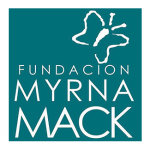 |
 |
| University Institute of Public Opinion El Salvador |
Myrna Mack Foundation Guatemala |
Institute on Democracy, Peace & Security Honduras |
Between 2014 and 2017, each public defender in Guatemala and El Salvador was assigned an average of more than 160 cases.
Between 2014 and 2019, Honduras and Guatemala employed an average of 271 and 158 public defenders, respectively. From 2014-2017, El Salvador's average was 259.
On average, 48 autopsies were assigned to each forensic expert per year in Honduras, 43 in Guatemala, and 31 in El Salvador.
Between 2014 and 2017, judiciaries issued an average of 10,249 sentences per year in El Salvador, 8,906 in Honduras, and 8,822 in Guatemala.
From 2014-2017, El Salvador reported the most case dismissals, averaging 15,589 dismissals per year, followed by Honduras (5,497) and Guatemala (3,260).
Although it has the smallest population, from 2014-2017 El Salvador’s judiciary registered the highest number of criminal cases each year.
Budgets for public prosecutors’ offices increased by 97% in Honduras and 137% in Guatemala from 2014-2019 and 55% in El Salvador from 2014-2017.
All three countries allocated nearly 3% annual expenditures to their defense ministries and 2.5% to 5.7% to their civilian police forces.
Although it had the smallest budget, El Salvador dedicated more resources to its judiciary and public defender’s office than other countries.
From 2014 to 2017, Guatemala had the largest annual average budget ($9.2 billion), followed by Honduras ($8.1B) and El Salvador ($4.8B).
The ministries of defense of all three countries denied our requests for information regarding the total number of military personnel.
From 2014 to 2017, Guatemala and El Salvador reported having 3 and 8 judges with criminal jurisdiction per 100,000 inhabitants, respectively.
On average, women only represented about 14% of the police forces in El Salvador and Guatemala between 2014 and 2017.
On average, women represented some 66% of public defenders in Honduras and 47% in Guatemala between 2014 and 2018.
Public confidence in the armed forces decreased drastically in all three countries between 2015 and 2017, with reductions between 5% and 9%.
There was a notable increase (some 4% to 6%) in public confidence in the judiciary in El Salvador and Guatemala between 2015 and 2017.
In the justice and security sector, citizens reported having more confidence in the armed forces than in other state entities.
El Salvador received the highest scores (36) on the Corruption Perceptions Index 2020. Guatemala and Honduras scored between 24 and 25.
From 2014 to 2019, extortion cases increased by 100% in Guatemala and decreased by 46% in Honduras. Cases decreased by 23% in El Salvador from 2014-2017.
While human trafficking cases decreased 52% in El Salvador from 2014-2017, they increased by 212% in Honduras and 36% in Guatemala from 2014-2019.
The number of sexual assault cases barely changed. It did not vary more than 2% in any country between 2014 and 2017.
Government data from 2014-2017 report that femicides increased by 84% in El Salvador and decreased by 4% in Guatemala and by 26% in Honduras.
Each country reported a decrease in the number of rape cases (10% to 16%), homicides (9% to 34%) and kidnappings (24% to 46%).
Honduras has the highest poverty rate (between 60 and 69%), followed by Guatemala (59%) and El Salvador (between 22% and 35%).
Among the three countries, the literacy rate (between 81% and 90%) and life expectancy (between 72 and 76 years) are comparable.
The urban population is highest in El Salvador (62.3%) and Honduras (53.7%). In Guatemala, the population is almost equally rural and urban.

